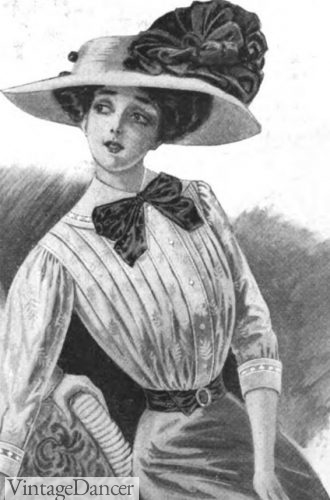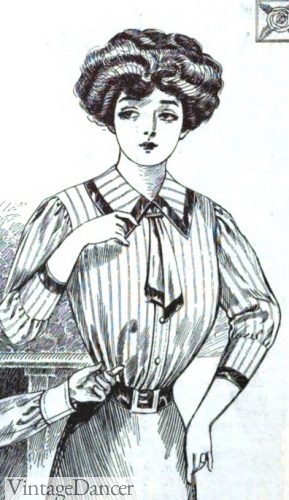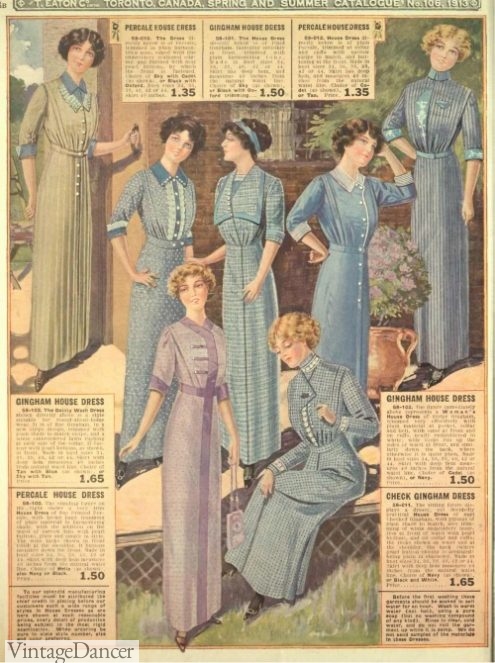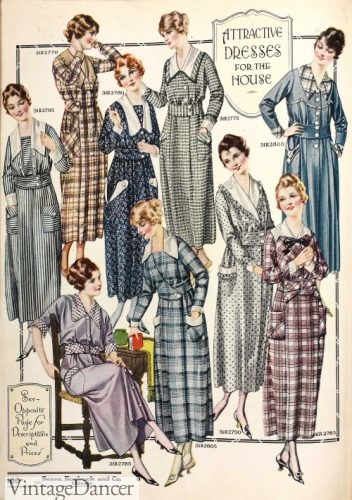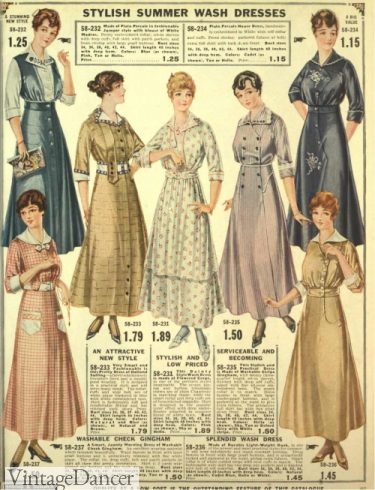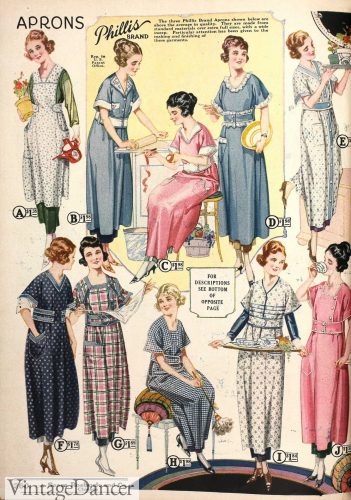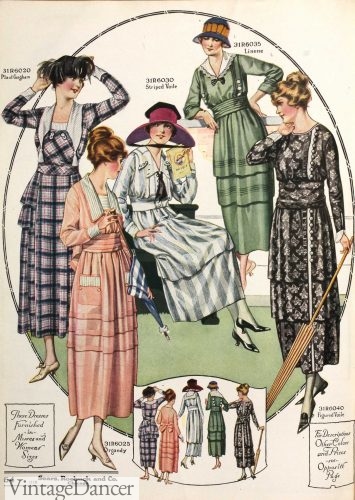The practical Edwardian house dress, a simple piece of clothing worn by women in the 1900s to 1910s, was one of the most colorful and charming items she owned. All classes of women wore house dresses at some point in the day, poor women, all day while middle classes only for a few hours if no company was expected. Upper class women had little use for a house dress when a household staff took care of the home’s needs.
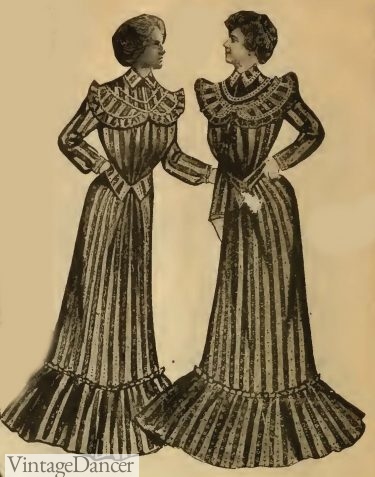
1902 house dresses
The house dress was never to be seen by anyone outside of a woman’s family or servants. It differed from a daytime outing dress in its informality, washable fabrics, minimal trim, and slightly looser fit. It was designed to tend to household chores, gardening or lounging.
1900 Wrapper Dress
Continuing on from the Victorian era the house wrapper dresses was what women put on in the morning, over lingerie, and went about their breakfasting or light household chores. It was essentially a shapeless dress, sewn in one piece, that buttoned down the front or overlapped. Pleats from the shoulders down to the floor made the dress full and boxy. A tie waist sash or a crisscross belt gathered in the waist.
Wrappers could be fancy, almost lingerie robe like, while others like daytime dresses. Tea dresses were built on the same design principles but were much more fussy. They were designed to be worn after 5pm and before dinnertime.
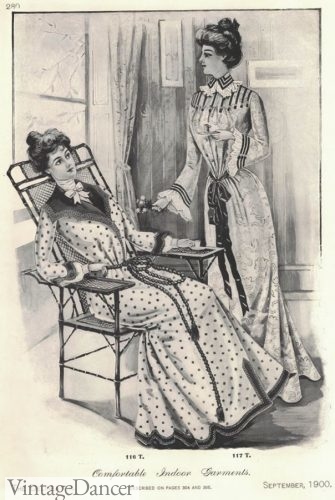
1900 fancy robe and dress style wrappers
Edwardian wrapper dresses followed dress trends, at least on the top. Besides pleats there were trends for large and small yokes, puffed shoulders, fold down collars, ruffles and lace trimming. Sleeves wee long with an open cuff for maximum comfort. Skirts were hemmed with a deep ruffle for most for the 1900s.
Fabrics tended to either be nightwear materials such as warm flannel or washable cotton percale. Fancy models could be satin or velvet. Each dress took about 8 yards for an average women (5’2) to make. Colors were black or dark blue with small patterns or white. Colorful stripes were also very popular and more cheerful- red, pink, light blue as well as black or navy blue.
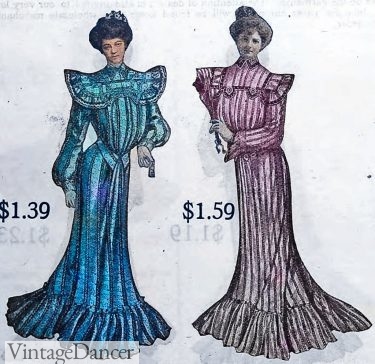
1904 wrapper dresses in blue and pink stripes
“The morning dress is ‘a loose, flowing dress, made high in the neck, with a belt at the waist, and with loose sleeves fastened at the wrist. It is important that a lady should always dress neatly at home. She is then ready to receive a morning caller without having to change her dress.’ “(Household Companion, 1909)

1909 Sears wrapper dresses in flannel or cotton percale
1910s House Dress
In the 1900s wrapper house dresses were more common than the shirtwaist style house dress. By 1910 the transition to the shirtwaist house dress was nearing completion.
1910s house dress designs followed those of day dresses with very high necklines, long sleeves (half sleeves were acceptable), a full skirt and ruffle hem. The ruffled bottom could be replaced when worn out. Extra fabric was saved for this purchase. Cuffs and collars could also be replaced with matching fabrics.
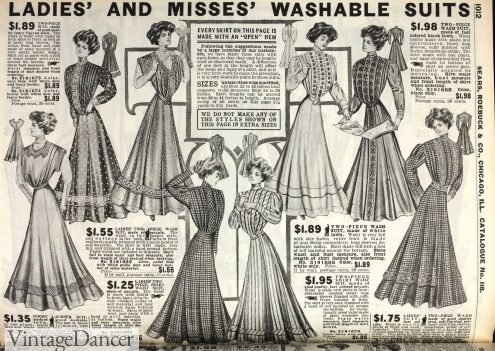
1909 house dresses
Like the wrapper, a house dresses was put on as one piece with buttons down the back taking about 8 yards of fabric in the early years but less as silhouettes changed. Two pieces, a top “waist” and a bottom skirt, were sewn together to form one fitted dress. The top remained full and pleated over the bust with roomy shoulders and tapered sleeves. The skirt was cut extra full at the hem so a woman could have full range of motion with her legs.
A matching belt could be worn at the waist. It was decorative, rather than functional.
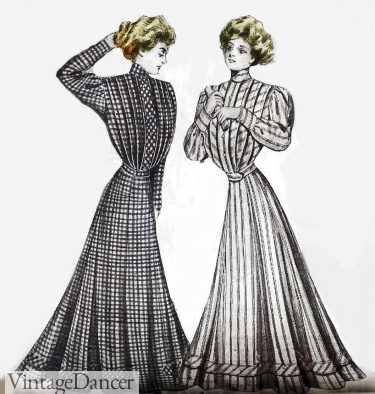
1909 house dress in black and white check and in black and white stripes
House dress fabrics are what I find most charming about the dresses. Cotton fabrics with thin vertical stripes, gingham check and polka dots or small prints that looked like polka dot from a distance. These fun little patterns would become identified with women’s house dresses for the next century.
“A neat gingham dress reaching to the ankles and wide enough for free movement of body, will clothe a woman appropriately and leave her
mind and body free and the work will go forward pleasantly and smoothly.” – 1909, American Homemaker magazine
Dark colors such as black and blue were the most dirt resistant but many more young women preferred white or lighter blues. An apron was essential in keeping these house dresses from becoming too dirty.
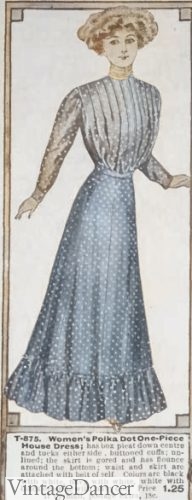
1909 polka dot house dress
Many women were choosing to follow the fashion trend of skirt and blouse separates and applying those fashions to house work dress as well. A washable cotton blouse (colored or white) and coordinated cotton, lawn or linen skirt in a darker color with a gingham apron on top was versatile for many uses. Once a skirt was worn out it could become a petticoat however women were advised never use a nice wool skirt, no matter how worn out, for house work.
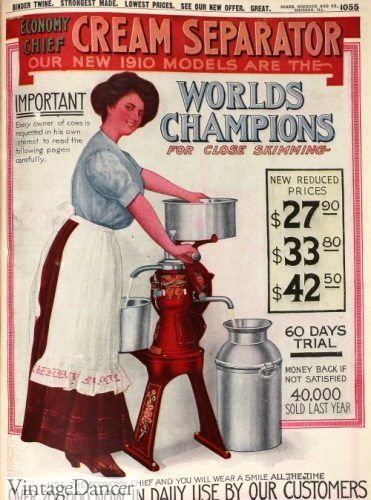
1910 Blouse, skirt and apron for this farmwife
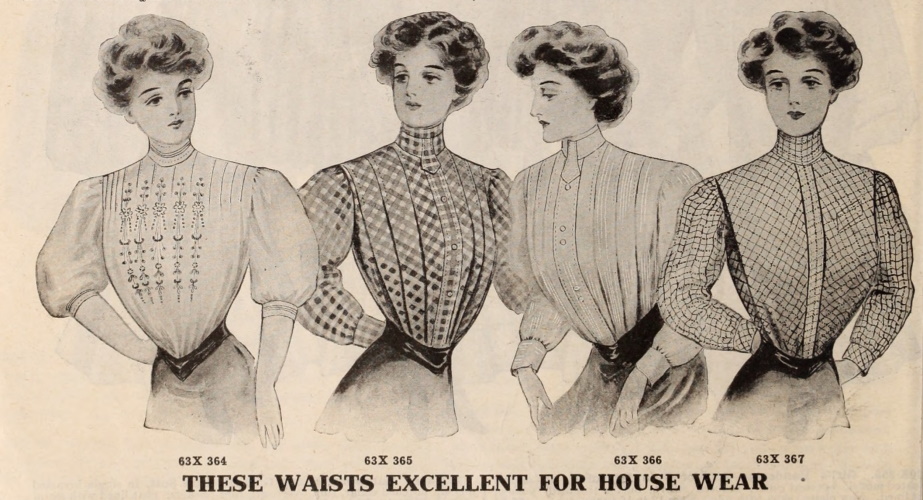
1908 house blouses- white lawn, black and white checks, white madras, black and white windowpane plaid
How to Make a House Dress
“Every housewife should have a clean fresh house dress each week; a dress solely for this purpose… Don’t improvise or get some fancy pattern of a “house dress,” some princess design that is a house dress in name only, but select a straight seven gored skirt, with a pleat or two at each seam with a deep hem or a couple of tucks on the bottom. Open the skirt front.
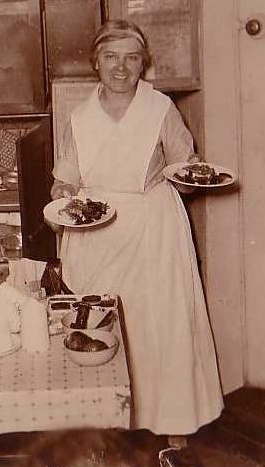
A gingham house dress and white apron for this home cook
Make the waist on a shirt waist pattern, easy and loose. Have the bands on both skirt and waist an inch or two larger than for your dress-up dresses, and when skirt and waist are completely finished, stitch the two hands together, and have opening in waist and opening in skirt correspond. The dress is now in one piece.
Make a fitted belt and stitch this over the joining, leaving one end longer than the other to pin over. Have the neck cut “Dutch,” or like the Peter Pan waists, with a sailor tie of white lawn. This is cooler in the summer than a tight collar.
- 1909 a Dutch collar (peter pan collar) waist (blouse)
- 1909 sailor collar blouse
Button and button holes are the best, or the hear-it-snap fastenings. Hooks and eyes are poor things on a wash dress, they 4 are constantly being pressed down with the iron. It is best to tailor the dress as much as you can, because it will keep its shape better in the numerous washings it must have.
In selecting ginghams buy designs that are rather dark but bright, the color predominating rather than white. Stripes, brown
checks, blue plaids, and black and grey combinations. Always have in mind the laundering qualities. A very light material is foolish because it soils so soon and you defeat your purpose in your choice of material. Have the dress comfortable, so that its period of usefulness is not to be too limited. Have good sensible working clothes, and you will be a better economist than you will be by wearing out your “tailor-made” around the house.”
– 1909, American Homemaker magazine
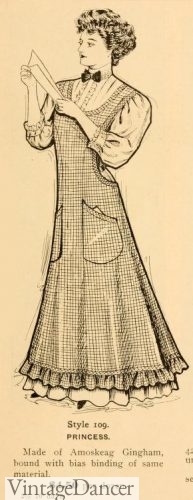
1904 gingham apron over skirt and blouse separates
1910-1914 House Dresses
From 1909 onward there were less and less distinction between house dress (to work in) and house dresses (to be at home in or receive un-important guests in.) Gingham prints usually meant work dress while all other small patterns, stripes, plaid and solid colors could serve either purpose.
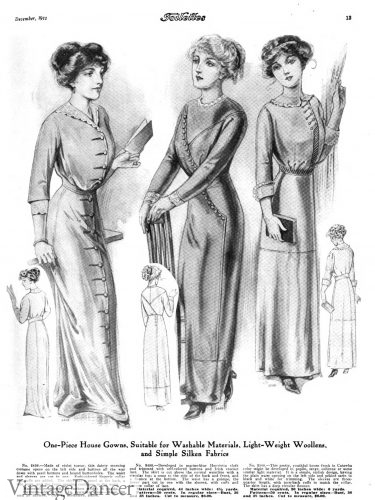
1911 afternoon house dresses with buttons down the front
House dress styles before WW1, slimed down into the column shape with round necklines and sewn on decorative details. Belts were attached higher on the waist, almost to empire.
The latest new style for house or day dress featured button off -center down the shirtwaist and partially down the skirt. This enabled women to dress themselves more easily.
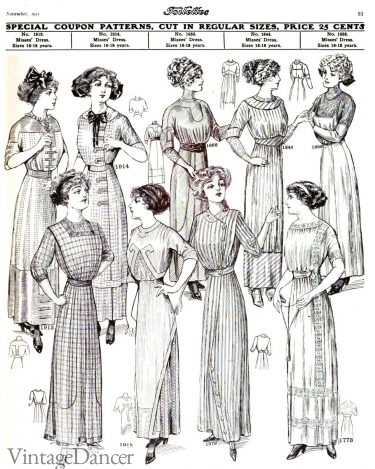
1911 house dress patterns
There was also the jumper or apron style dress which looked like two separate pieces but was sewn as one. Fold out collars also returned in fashion in matching or color coordinating trim. And sleeves shorted up to the elbow in summer.
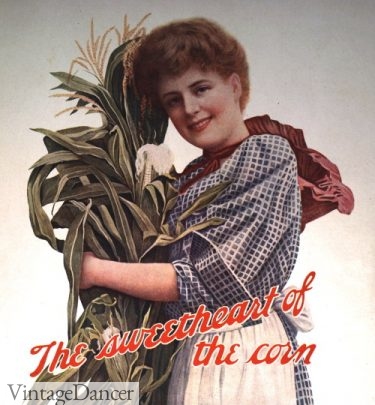
1911 working house dress with sleeves rolled/push up
Fabrics continued to favor washable cotton for working house dresses while day house dresses could adopt any number of fashionable but not too fancy materials (wool, heavy silk.)
House dress colors favored pastels- light blue, lilac purple, light grey as well as the classic black and white check. Vertical stripes alternating in white were even more popular than checks.
- 1913 Eatons house dresses
1914-1919 House Dresses
WW1 made house dresses and informal daytime house dresses more important than ever. Because of that there were even more styles, colors, patterns and variety of materials to choose from. It was critical that women be able to dress themselves and move without hinderance around the house or into town because there were no more maids to serve them.
- 1916 plaid, check and solid dresses with white collars
- 1916 house dresses
Skirts grew wider and shorter with a “walking” length of above the ankle. Sleeves on summer models moved up above the elbow too. Necklines became slightly less covered up with more small V necks and square necks.
House dresses adopted white collars as both a pretty embellishment and practical trim because they could easily be removed, washed and replaced. Maids had been wearing white collar uniforms for many years prior. Now that housewives were officially maids, they looked the part.

1914 white cuff and collar house dress and apron
Collars and pockets could also be made in another complimentary fabric to save on expense. Last year’s house dress could easily be retrimmed in scrap fabric and made new for another year.
- 1919 house dresses and aprons
- 1919 house or daytime dresses
As you can see from these color images, there was a color explosion in house and daywear. While stripes and gingham remained classic house dress, large plaids were the newest and most popular. Large prints hid dirt much better then solid colors so they were more practical than plain colors and small patterns. The variety of color combinations in making a plaid print made them more cheerful too.
- Continue on to 1920s house dresses.
- Take a look at Edwardian Aprons, sewing patterns, ready-made aprons.
- See more fabric swatches and color trends for the 1900s and 1910s.
- Sew an Edwardian house dress with a pattern
Debbie Sessions has been teaching fashion history and helping people dress for vintage themed events since 2009. She has turned a hobby into VintageDancer.com with hundreds of well researched articles and hand picked links to vintage inspired clothing online. She aims to make dressing accurately (or not) an affordable option for all. Oh, and she dances too.
